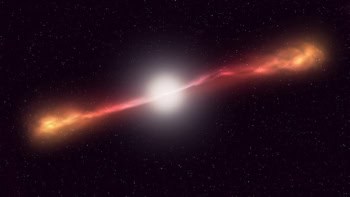
A new observation of electron and positron cosmic rays has confirmed the existence of what could be a “cooling break” in the energy spectrum at around 1 TeV, beyond which the particle flux decreases more rapidly. Aside from this break, however, the spectrum is featureless, showing no evidence of an apparent anomaly previously associated with a dark matter signal.
Cosmic ray is a generic term for an energetic charged particle that enters Earth’s atmosphere from space. Most cosmic rays are protons, some are heavier nuclei, and a small number (orders of magnitude fewer than protons) are electrons and their antiparticles (positrons).
“Because the electron’s mass is small, they radiate much more effectively than protons,” explains high-energy astrophysicist Felix Aharonian of the Max Planck Institute for Nuclear Physics in Heidelberg, Germany. “It makes the electrons very fragile, so the electrons we detect cannot be very old. That means the sources that produce them cannot be very far away.” Cosmic-ray electrons and positrons can therefore provide important information about our local cosmic environment.
Today, however, the origins of these electrons and positrons are hotly debated. They could be produced by nearby pulsars or supernova remnants. Some astrophysicists favour a secondary production model in which other cosmic rays interact locally with interstellar gas to create high-energy electrons and positrons.
Unexplained features
Previous measurements of the energy spectra of these cosmic rays revealed several unexplained features. In general, the particle flux decreases with increasing energy. At energies below about 1 TeV, the decline is a steady exponential. But at about 1 TeV, the decline steepens with a larger exponential at a curious kink or break point.
Later observations by the Dark Matter Particle Explorer (DAMPE) collaboration confirmed this kink, but also appeared to show peaks at higher energies. Some theoreticians have suggested these inhomogeneities could arise from local sources such as pulsars, whereas others have advanced more exotic explanations, such as signals from dark matter.
In the new work, members of the High Energy Stereoscopic System (HESS) collaboration looked for evidence of cosmic electrons and positrons in 12 years of data from the HESS observatory in Namibia. HESS’s primary mission is to observe high-energy cosmic gamma rays. These gamma rays interact with the atmosphere creating showers of energetic charged particles. These showers create Cherenkov light, which is detected by HESS.
Similar but not identical
The observatory can also detect atmospheric showers created by cosmic rays such as protons and electrons. However, discerning between showers created by protons and electrons/positrons is a significant challenge (HESS cannot differentiate between electrons and positrons). “The hadronic showers produced by protons and electronic showers are extremely similar but not identical,” says Aharonian; “Now we want to use this tiny difference to distinguish between electron-produced showers and proton-produced showers. The task is very difficult because we need to reject proton showers by four orders of magnitude and still keep a reasonable fraction of electrons.”
Fortunately, the large data sample from HESS meant that the team could identify weak signals associated with electrons and positrons. The researchers were therefore able to extend the flux measurements out to much higher energies. Whereas previous surveys could not look higher than about 5 TeV, the HESS researchers probed the 0.3–40 TeV range – although Aharonian concedes that the error bars are “huge” at higher energies.

AMS confirms positron excess
The study confirms that, up until about 1 TeV, the spectrum decreases exponentially. The team measured this exponent to be about 3.25. At about 1 TeV, a sharp downward kink was also observed – with an exponential decrease of about 4.5 at higher energies. However, there is no sign of any bumps or peaks in the data.
This kink can be naturally explained, says Aharonian, as a “cooling break”, in which the low energy electrons are produced by background processes, whereas the high-energy electrons are produced locally. “Teraelectronvolt electrons can only come from local sources,” he says. In theoretical models, the intensity of both fluxes would decay exponentially, and the difference between the exponents would be 1 – close to that measured here. Aharonian believes that further information about this phenomenon could come from techniques such as machine learning or muon detection to distinguish between high-energy proton showers and electron showers.
“This is a unique measurement: it gives you a value of the electron–positron flux up to extremely high energies,” says Andrei Kounine of Massachusetts Institute of Technology, who works on the Alpha Magnetic Spectrometer (AMS-02) detector on the International Space Station. While he expresses some concerns about possible uncharacterized systematic errors at very high energies, he says they do not meaningfully diminish the value of the HESS team’s work. He notes that there are a variety of unexplained anomalies in the energy spectra of various cosmic-ray particles. “What we are missing at the moment,” he says, “is a comprehensive theory that considers all possible effects and tries to predict from fundamental measurements such as the proton spectrum the fluxes of all other elements.”
The research is described in Physical Review Letters.



